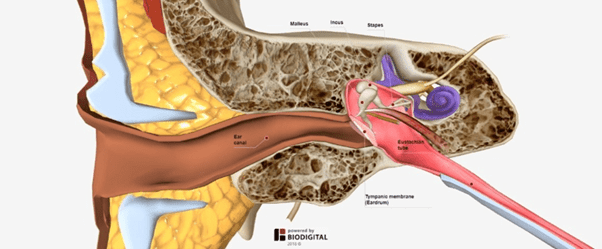Otitis media with effusion (OME)
Glue Ear
Glue ear, also known as adhesive otitis, Otitis media with effusion (OME), or serious otitis media, is a condition in which there is fluid build up in the middle ear behind the ear drum. The disorder is much more common in children due to Eustachian tube maturation.

Symptoms of glue ear
Glue ear is often asymptomatic apart from causing some hearing loss. In fact, a child with glue ear may not have any complaints at all but you may notice that he or she:
- talks louder than usual
- has difficulty hearing others speak at normal volumes
- can’t hear noises from far away
- has trouble sleeping
- has balance problems
- struggles to hear the teacher clearly at school and often daydreams
- asks for people to repeat themselves
- turns up volume on the TV and other devices
- complains about ringing or buzzing in their ears
Adults with glue ear may have similar symptoms as children but may also feel pressure or fullness in the ear and discomfort.
Glue ear can resolve without treatment but if it is chronic, persisting longer than a few months, can cause permanent hearing damage and also delays in speech and language development and auditory processing skills.
Causes of glue ear
Glue ear happens when thick fluid builds up inside your middle ear. As with general ear infections, glue ear tends to be more common in children. This is because the eustachian tubes deep inside the ear are narrower than an adult’s and more prone to becoming blocked. These tubes are responsible for ventilating the middle ear cavity, maintaining pressure equalization and helping the ear maintain healthy space free of excess fluids.
Normally, the space behind the middle ear is only filled with air. But sometimes fluid can build up in the space as a result of an illness, such as a cold or virus.
Severe allergies may also cause such issues inside the middle ear. In such cases, the eustachian tubes can become swollen and constricted, leading to fluid build up.
Other risk factors for glue ear may include:
- age, especially under age 2
- being bottle-fed
- daycare settings, due to a higher risk of germ exposure
- seasonal allergies
- poor air quality
- tobacco smoke exposure
Glue ear and ear infection
Hearing loss can also occur with an ear infection known as acute otitis media. However, glue ear and ear infection aren’t the same thing. Unlike glue ear, an ear infection is quite painful and may be accompanied by fever and fluid drainage. An ear infection requires medical treatment to prevent hearing loss and possible eardrum damage.
Diagnosis
Glue ear diagnosis routinely starts with an examination at your doctor’s office. They generally use an otoscope to look inside the ear which can help them see if there is a fluid build-up. They may also refer to an audiologist to test the middle ear function using tympanometry and to conduct a hearing assessment. If glue ear is chronic, where it keeps coming back, or if it lasts for longer than three months, there may also be a referral to an Ear nose and throat specialist for medical treatment.
Treatment
Glue ear is not always treated. The GP will often wait to see if the symptoms resolve on their own. Your child may be monitored for up to a year in case their symptoms change or get worse. Other treatment may involve:
- Autoinflation can sometimes help fluid in the ear to drain. It’s done by either blowing up a special balloon using 1 nostril at a time or swallowing while holding the nostrils closed.
- Antibiotics may be prescribed if glue ear causes an ear infection.
- Severe or chronic cases of glue ear may require treatment from a specialist, such as an ear nose and throat (ENT) doctor. A small operation may be advised by an ear specialist if your child’s glue ear persists, or is severe. This involves inserting small tubes called grommets (ventilation tubes). The operation isn’t done as often as it used to be because it is now realised that most cases of glue ear get better without treatment. Chronic glue ear is also sometimes treated with a type of surgery called an adenoidectomy. During this procedure, your doctor removes your adenoid glands from behind your nose that may be contributing to fluid buildup in your ear.
Prevention
Glue ear may be difficult to prevent, especially in young children. One way to help prevent chronic glue ear is to try to stay healthy and support your or your child’s immune system as it’s developing. Also, identify and treat allergies and limit exposure to smoke and similar inhaled irritants.
While glue ear can present serious complications, this common childhood condition tends to resolve on its own in many cases. It can take as long as three months to fully clear up. As fluid drains from the ears, you’re hearing will improve on its own.
If you notice any significant hearing difficulties, signs of an ear infection, or if your glue ear lasts longer than three months, then it’s time to see a doctor. Once you’ve had glue ear, you’ll need to see your doctor regularly to make sure more fluid doesn’t build up in the middle ear and cause hearing issues.
